The Parrot Society UK
Moulting
The Normal Moulting Process in Birds
(Based on a presentation made to the Association of Avian Veterinarians Annual Conference in August 1998)
The header page of this section on feathers already explains that feathers are unique to birds, and come in a variety of shape, colour, structure and function. The associated article on Feather Plucking in Parrots discusses its many possible causes, including infections, deficiencies, genetic abnormalities, dietary and hormonal influences, etc. Like any other aspect of veterinary medicine, to be able to deal with the abnormal. one has first to understand what is normal. One cannot hope to diagnose and treat a problem affecting a bird’s feathers without first appreciating the normal process of growth and replacement. Feathers are not permanent organs on the bird: they have a finite life and are shed and replaced on a regular basis. This replacement process is known as moulting, and it is this moulting procedure that is addressed in this article.
Feather structure & function. It is not within the scope of this article to give a detailed description of the anatomy of feathers, but it is essential to have a fundamental understanding of the shapes and variety of feathers in existence. Normal feathers are grouped as contour feathers, or plumes, which as the name suggests give the over-all shape to the bird. They include the outer body and head feathers, and those on the wings and tail. They consist of a central supporting quill from which extend interlocking barbs and barbules. It is this part of the feather that carries the colour of the plumage. The colours are imparted by a combination of pigment granules within the feather structure, and light refracted through the hollow areas and the oily coating. The long contour feathers of the wing are collectively known as remiges, and those of the tail are retrices. The whole of the feathers on the bird constitute its plumage.
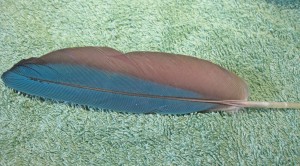
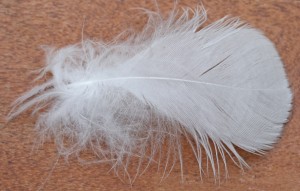
Contour feathers showing the quill, vane of interlocking barbs and barbules, and softer plumes
The second group includes down feathers, or plumules, which are softer and shorter than contour feathers. They do not have interlocking barbules, hence the barbs form a looser structure giving a softer feel and allowing air pockets between them. The trapped air provides an insulating layer in the plumage, and these down feathers are found under the contour feathers of the body. They are present exclusively in the chicks of many species before contour feathers develop. Those chicks which hatch from the egg already possessing downy plumage are known as ptilopaedic; those which hatch with no feathers but grow their down later are psilopaedic.
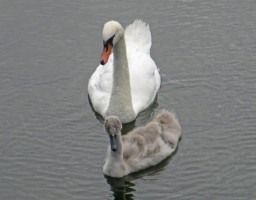
Adult swan, with cygnet showing grey, fluffy plumage
Modified plumes known as powder down feathers are found on the flanks of many species, notably African grey parrots, Cockatiels, and white Cockatoos. These are small plumes with brush-like tips that break up into a fine white powder, which the bird then disperses through its plumage as a conditioner. They are generally the first feathers to be damaged and disappear if a bird is infected with virus diseases such as Psittacine Beak and Feather Disease (PBFD). Psittacine Beak & Feather Disease
The third group includes filoplumes, possessing long shafts with a small tuft of barbules at the tip.
The feathers are arranged on the body in regular tracts known as pterylae, and this pterylosis can be distinctive for each species. The featherless areas are apteria, which are obvious in the young chick, but become covered with the overlapping feathers as the plumage grows. These areas will be exposed again if the plumage gets extremely wet or oiled, or if the bird starts to lose an excessive number of feathers. The presence of apteria may facilitate heat loss when required: the bird will raise its plumage when hot to allow the circulation of air over the skin. Penguins have no apteria.
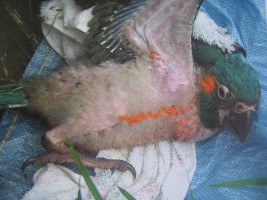
Blue-throated Macaw chick showing downy feathers, with new yellow feathers erupting in rows (pterylae) and blood feathers in wing
The combination of feather types on the bird provides a variety of functions for the plumage. These include flight, insulation, waterproofing, swimming, sound production, camouflage, tools for courtship display, as well as species and individual identification. Many avian species are visually sexually dimorphic – i.e. morphological features such as combs, wattles, cere and eye colour are different in male and female. Most sexual dimorphism is evident in feather form and colour, but recent research suggests that even in species that appear identical to our eyes, there are differences detectable by the birds at the ultraviolet end of the spectrum. Ultraviolet Light & Skin Cancer Shed or plucked feathers may also be used as nest-lining material by the same bird or other individuals collecting the fallen plumes. Contour feathers in many species may be considerably modified to form distinctive display or identification features. Examples are the crest feathers of the Crowned Crane, Cockatoos, and the Peacock; or the flamboyant tail feathers of the Lyre Birds, Birds of Paradise, and again the Peacock.
The important waterproofing function of feathers is provided partly by a coating of oils. The prime source of such oil is the preen gland, situated above the base of the tail, but the importance of this gland as a provider of waterproofing material is equivocal. All avian species have waterproof plumage, but not all species have preen glands, and if the gland is removed or damaged, the bird will still retain the ability to waterproof its plumage. The greater effect of this feature is provided by the interlocking barbules, which when properly in place, offer a physical barrier to water. To maintain this effect, it is essential for there to be a normal preening regime, thus if a bird is unwell, injured, or in pain and cannot preen, the plumage will rapidly become ragged, dirty, and non-waterproof. Also, if barbule quality is affected by underlying disease in the bird, by dietary deficiencies, by parasitic attack, or environmental factors (dryness, smoke) the barbules will not properly interlock, and the waterproofing effect will be lost.
Feather growth and replacement. The feather quill is rooted in a follicle, which is a tubular invagination in the skin with its own blood and nerve supply. The growing feather has a rich network of capillaries within the base of the quill, supplied from the follicular arteriole. This blood source provides an efficient supply of nutrients to the rapidly growing plume, and gives rise to the name 'blood' or 'pulp' feather. Once the feather is mature, this pulp atrophies, leaving a light, hollow quill.
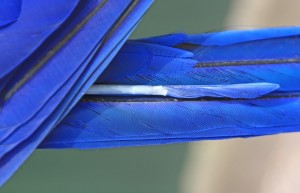
Tail feathers of a macaw, showing new feather in its protective sheath of keratin
The emerging feather is encased in a sheath of shiny white or grey keratin, which is rubbed off by the bird in the process of preening. Mutual preening of companion birds, apart from strengthening a pair bond, allows the removal of such keratin from feathers on the head, which are difficult to reach by the bird itself. The emergence of the feather at this stage causes some irritation to the bird, and the appearance of several feathers all at once will often promote severe scratching and biting. Thus if a bird does lose many feathers for whatever reason, their subsequent replacement may lead to excessive preening which can easily become picking, with the loss of more feathers, followed by new feather growth and further irritation….. In this way a cycle of feather picking is easily established. The presence of many sheathed quills on a bird may indicate some pain and difficulty in preening (e.g. arthritis), or more usually is an indicator of deficiency problems or systemic disease.
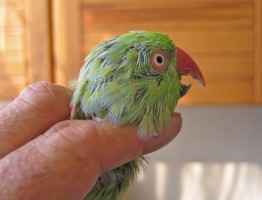
Ring-necked Parakeet showing persistent quills on head feathers. May indicate arthritis and an inability to preen, deficiency disease, or viral infections like PBFD
The loss of a feather from a follicle will be followed by the growth of a new plume at the same site. There is some discussion as to whether the drop of an old feather that has finished its useful life then stimulates the growth of a new one, or whether it is the development of the new feather at the base of the follicle which then forces out the old plume. It is now generally accepted that the latter is the true picture. It is true that a feather that is lost, either by accident or design, will be replaced by new growth in 4-6 weeks. This has an advantage to the bird that loses its feathers in an attack or accident: there are some species like pigeons and touracoes that can shed their feather easily in such a situation, leaving the predator or handler with a mass of feathers, while the bird makes its escape. Such loss is known as a 'stress moult', or 'fright loss'.
This rapid replacement after removal of the old feather also has a value to the avian practitioner, who can pull out damaged, split quills to encourage new growth. This has a particular application in the case of a bird that has had a severe wing clip, leaving short quills which become frayed and split, and a source or irritation to the bird. This in turn can encourage feather picking, and will obviously restrict its flight. To wait for the natural moult to eliminate these quills can mean that the bird is in discomfort for an unreasonably long time, whereas their removal (usually requiring sedation or anaesthesia) will promote a rapid return to full plumage.
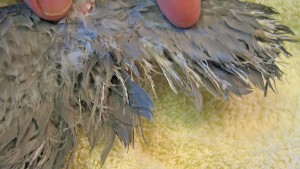
Severely hacked wing of an African grey parrot, followed by self-mutilation of the damaged feathers
The normal replacement of feathers shed from the follicles is known as the moult (Molt in American English!), and it is a sequential, cyclical process. The same follicle is capable of growing a series of different feathers (shape or colour) throughout the life of the bird or its breeding cycle. Thus the newly-hatched chick will start with a natal down, which is replaced by the second plumage. These are shorter and narrower than the adult feathers, thus although the bird quickly reaches adult body size, it may actually appear smaller. Colouring will also be different to the adult plumage in many cases (e.g. Ringnecked Parakeet, Bald Eagle).
The third plumage that follows gives the bird its adolescent appearance, and the time scale between these plumage changes will depend on the species and development speed of the bird. In general, large species like Eagles and Albatross take several years to reach sexual maturity, whereas small birds like quail and most passerines are mature in a matter of months. The fourth plumage is the mature adult phase. Malnutrition may delay this development, or result in the appearance of feather deformities. (see below).
Factors Affecting the Moulting Process. Once mature plumage is attained, the feathers will be replaced at variable intervals depending on the species. Some large birds like Cranes and Eagles replace their entire plumage only once every 2nd year. Many parrots like African Greys and Amazons replace their feathers to some extent continuously throughout the year. This is important in clinical practice and especially in pet birds – the loss is exaggerated by warm, dry conditions in centrally heated homes, but will also be affected by dietary factors, stress, and internal disease.
Other species will moult once, twice, or three times a year. Most will start to lose their feathers after breeding: in most northern hemisphere passerines, for example, this will occur in early summer. The moult usually coincides with a cessation of singing - either because the song is no longer necessary for courtship, or because the bird’s energies are directed at feather growth, or even because the bird is vulnerable at the time and does not want to attract predators.
When the breeding plumage differs from the non-breeding colours, these species will moult twice a year (e.g. pheasants, most ducks). After breeding the colourful display (nuptial) plumage is replaced by the generally dowdier off-season (eclipse) feathers, then these will be replaced again before the next breeding period to restore the birds to their full glory.
A few species like the Willow Ptarmigan will moult three times a year to maintain their protective camouflage in the changing sub-arctic terrain, from the summer browns, through the mid-season brown and white, to the winter full white.
Powder down feathers are shed continuously throughout the year in those birds that possess them.
The process of feather loss in most birds is sequential and bilaterally symmetrical, so that they are replaced progressively over a period of several weeks and the bird is never without full cover. This means that most birds can still continue to fly, since only one or two primary flight feathers will be missing from each wing at any one time. Like the initial stimulation to moult, this moulting period may be prolonged or affected by nutritional or other factors, such as temperature and humidity. This gives rise to the expression 'prolonged moult' or 'stuck in the moult'.
A few species, primarily waterfowl, shed all their flight feather at one time, rendering them flightless for a period of 3-6 weeks. This obviously makes them vulnerable to predation at this time, but again is a factor that needs to be identified as a normal process by the avian clinician, and not considered to be pathological.
There is a considerable 'metabolic cost to the moulting procedure: figures are quoted of anything between 15% and 30% rise in metabolism above Basal Metabolic Rate (BMR) during the moult. Apart from raising the bird’s general nutritional requirements, specific amino acids are required for protein formation. It is well documented that deficiencies of specific amino acids will result in incomplete feather formation, usually manifesting as a colour change or dilution. Thus lysine deficiency in poultry, or choline deficiency in cockatiels will both lead to achromatosis (loss of colour).
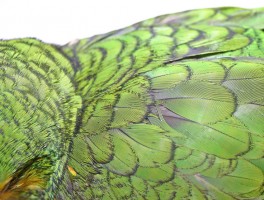
Amazon parrot with poor feather quality - tips appear black and frayed
The feathers account for some 20-30% of the bird’s structural protein. Thus the loss of these feathers during moulting will be reflected in a reduction in serum protein values. There is an increase in nutritional demand for protein for the new feather growth, hence the importance of providing readily metabolisable dietary protein to birds that are moulting or feather picking. Blood calcium levels also drop at this time, so calcium supplementation in captive birds would be as important for feather replacement as it is for breeding birds.
This demanding process on the bird’s metabolism, probably second only to egg-laying, places the bird in a vulnerable condition, when it can fall easy prey to enemies, and will be more susceptible to infection. Sub-clinical illness that in the fit bird would be suppressed, may overcome the bird at this time.
This whole process of normal feather replacement will be initiated, maintained, or modified by a number of interacting factors, which make for a complex picture. These will include hormonal, seasonal, photoperiod, nutritional, and local (on the skin) influences. Other less usual agents would include bleach, dirt, oil, water, parasitism or other intercurrent disease, stress or fright, and extremes of temperature. The primary factor in most species is the photoperiod: birds respond to changes in daylight hours, perceived via the pineal gland and hypothalamus. The response is to prepare the bird for the approach or end of breeding, or a change in food availability.
Hormonal influences on moulting vary considerably from species to species. Thyroid function has always been considered to be the most important, and certainly hypothyroid birds will have serious delays and abnormalities of the moult. However, gonadotrophins, progesterone, and oestrogens are also significant. Medications can also affect the moult and feather growth. It is well recognised that the intestinal parasiticide fenbenzadole can damage feathers if it is administered during a period of new feather growth.
Thus, normal feather growth and replacement is a natural process that can be affected markedly by captivity. Diet, temperature and humidity will influence feather quality and the moulting pattern; the cage or aviary may cause physical abrasion to the feathers if the bird is confined in a small area for long periods. Wing clipping, especially if performed too severely (commonly during capture from the wild) will result in short quills with frayed ends, which will irritate the bird and predispose to plucking. These damaged feathers are often not moulted out at the normal interval. The clinical work-up of any bird showing a problem with its plumage would obviously include tests for viruses, fungi, and bacteria, but do not assume that every feather abnormality has an infectious cause. As mentioned in other articles, most such cases will prove to be the result of dietary, environmental, stress, or hormonal influences.
© Alan K Jones July 2004, updated Feb 2019
